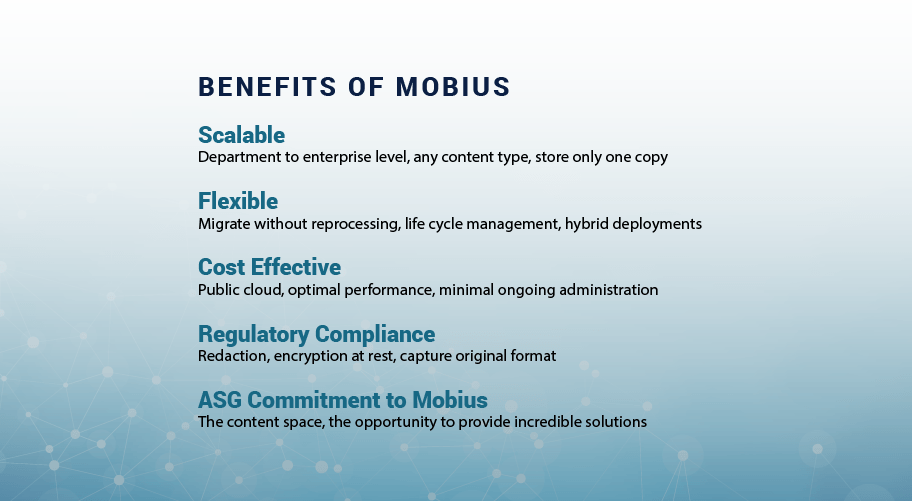Zia recently hosted a webinar with ASG Technologies entitled, “Your Future With CMOD: Three Considerations.” Presenting the webinar were Jim Ilardi, Sr. Solutions Engineer at ASG, Greg Wilson, Director of Sales, Content Services at ASG, and Ryan McVeigh, Managing Partner at Zia Consulting.
The goal of the webinar was to look at some of the effects of the sale of Content Manager OnDemand (CMOD) from IBM to UNICOM. CMOD development & support teams moved to UNICOM in 2016. While IBM says this will be better for customers and that no changes will occur, Jim Ilardi shared some things that companies should be concerned about. While development of CMOD has moved, there are still auxiliary products used in CMOD implementations, such as Content Navigator, which are still developed by IBM. If there are new releases, or bugs and fixes needed, who will handle them? In the past year and a half, a significant number of CMOD sales and technical sales staff has been eliminated. In the Gartner 2017 Magic Quadrant for Content Services Platforms we read:
“Changes in top management and key content services personnel in recent years have had a negative impact on IBM’s content services product development and strategy.”
What is the long-term goal for IBM? We’ve seen that IBM is becoming daily less concerned with ECM and is doing less with the products. Because IBM is trying to push customers to their private cloud, SoftLayer, how will they support public cloud platforms like AWS or Azure? Gartner again states:
“IBM has not moved as quickly as some competitors to embrace the public cloud. IBM and its partners host IBM content applications on managed private cloud deployments. Customers and prospects looking for public cloud services may find that the vendor’s public cloud offerings will not meet their requirements for some services.”
As the cloud-based ECM market evolves, enterprise customers are looking to modernize their legacy environments with next-generation content solutions that offer the flexibility to store their content in the cloud, on-premises, or both (hybrid environment). They may also desire to leverage a managed services model.
Greg Wilson then discussed how Mobius, a content services platform from ASG, helps companies tackle the challenges of storing and managing unstructured data. Mobius is a hybrid content platform that tackles the scale of true enterprise volumes as well as the specific content needs of departments and end users. Architects like the flexibility and strength of the architecture and compliance teams have their regulatory requirements met with encryption at rest, redaction, and records management. Mobius is a service-oriented architecture with a comprehensive suite of services around content for multi-tiered lifecycle management, to federated search and integration services as well as RM, audit, and analytics.
From a policy management perspective, everything is centralized and doesn’t require third-party systems. Products are brought together through integration and everything is built within the platform. From a policy management perspective, there’s a single view into the platform which covers classification, management, governance, and encryption. This also covers the security around searching and retrieving as well as redaction and extracting information from the system.
Because of the ability to offer both public cloud and on-premise deployment (Mobius is also AWS certified with Azure certification coming) companies can set up dev environments in hours, not weeks. You can also leverage content from multiple applications and platforms including disparate content repositories, ERP, LOB, etc.

Mobius provides unified and simplified management of content regardless of content type, size or platform, as well as customized document processing and output management. Access, index, link, and store petabytes of information in any format from virtually any data sources across multiple systems (mainframe, distributed, and cloud).
Mobius can run anywhere and the deployment strategies give customers freedom to decide what makes sense for your business. Whether it’s a traditional on-premise deployment or fully-managed services in the cloud, this flexibility is able to provide cost savings at every level.
Ryan McVeigh took over the presentation to talk about the Zia content migration process, which provides you with a proven and tested methodology. Zia combines knowledge with a range of best-of-breed migration tools (rather than being limited to a single tool), allowing them to select the right one for your project. The process begins with a discovery session to determine the volume of content, data sources, metadata, lifecycle, etc. Once this is established, they determine the best way to extract it and map it to the target while adhering to governance policies. Transformation needs are determined and business rules applied prior to any migration occurring. This allows you to consider how content has been managed and stored and change things to work best for you. At this point the content is migrated, auditing and indexing occurs, and final verification is conducted. Read more in the migration whitepaper here.
Is CMOD working for you in the long term? What are your next steps? If you have questions on updating your content management, don’t hesitate to contact us today for a free conversation to learn about your goals.
To watch the recording of this webinar, click here.

